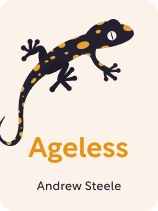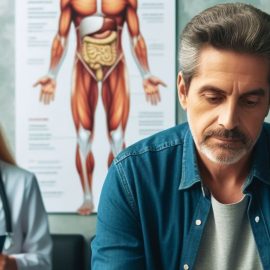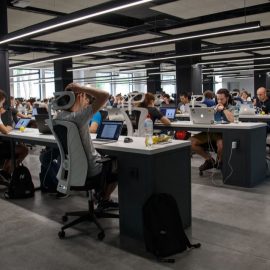
What’s Ageless by Andrew Steele about? Is there a way to slow down aging altogether?
Though we don’t like to think about it, we’re all going to get old. But in Ageless, Andrew Steele contends that aging isn’t as inevitable as it seems.
Read below for a brief Ageless book overview.
Ageless by Andrew Steele
In his Ageless book, Andrew Steele argues that we can treat—and even cure—aging. He explains that with scientific advances that are already being tested, we can change the course of the biological processes that make us less healthy as we get older. He contends that one of the most consequential steps we can take as a society is to invest in science that will make longer, healthier lives possible for future generations.
After earning a Ph.D. in physics at the University of Oxford, Steele determined that aging is the “single most important scientific challenge of our time.” So he shifted to computational biology, a field where researchers use large sets of data to understand the human body as a system. Ageless, published in 2020, is Steele’s first book.
In this guide, we’ll examine how Steele defines aging and debunks common myths about what happens as we grow old. We’ll also explore the processes behind aging. We’ll then look at how we might cure aging with what scientists know now and with what they might discover in the future, putting the ideas Steele details into the context of the latest research in the field and comparing his predictions to those of other experts.
(Shortform note: Experts don’t agree on the extent to which aging is treatable, but many—like Steele—are optimistic. Some view the body as a machine that can run as long as we maintain it, and others predict that we’ll use DNA editing to make the body immune to viruses and genetic diseases, and thus, we’ll reverse aging. Conversely, some scientists expect that we can’t cure aging because of the limits of our cells. And the idea that aging can be reversed is controversial: Some experts assert that aging comes down to a thermodynamic process that’s irreversible.)
What Is Aging?
Though we all know on a basic level what “aging” is, scientists often use common terms differently than the general public. In this section, we’ll look at how Steele and other experts define aging. We’ll also explore common myths that prevent laypeople and scientists alike from understanding aging as a process we can modify. Plus, we’ll examine exactly what kind of future Steele foresees if we can intervene in the aging processes that make us less healthy and fit.
How Should We Think About Aging?
Steele uses the word “aging” to refer to the process that causes our health to decline—and our likelihood of getting sick or dying to grow—as we get older. A key insight is that the diseases that kill us occur because of the aging process. Steele explains that age is the most significant risk factor for heart disease, stroke, dementia, and cancer, which we often think of as causes of death. He contends that because aging sets these diseases into motion, aging itself is the cause of approximately two-thirds of deaths globally.
Steele explains that even if we don’t develop heart disease or cancer as we get older, none of us are immune to the effects of aging. As we age, we experience more minor physical and mental changes that might not be considered diseases, but still reduce our quality of life: We get less physically fit, our health worsens, and our thinking and memory decline. Steele sees aging as a problem of human suffering—suffering that doesn’t have to be our fate.
What Do We Get Wrong About Aging?
Steele writes that a few mistakes in our thinking about aging prevent us from understanding how the process works—or from realizing how much we can change the relationship between age and health. The first of these mistakes is to think that aging is inevitable. Steele argues that we don’t have to age as we currently do. He explains that by studying the biological causes behind age-related diseases, scientists can learn to slow, reverse, or prevent them altogether.
The second mistake—which follows from the idea that scientists can study the biological causes of age-related diseases—is that we fixate on diseases rather than on the aging process itself. Steele writes that we think of the diseases associated with age as separate processes, but they’re actually set into motion by physiological changes that affect our entire body.
Finally, a third mistake is to think that the goal of curing aging is to live forever. Steele writes that the goal isn’t to become immortal but to become “ageless” by living healthier lives to the point that our risk of death won’t be correlated with our age anymore.
What Would It Mean to Cure Aging?
The idea of increasing human lifespans is complicated not only on a scientific level but also on an ethical level. Steele admits that it quickly gets tangled up with questions about population growth, social inequality, and the environment. Yet he argues that the benefits of eliminating the suffering of aging outweigh the costs, thus making it important to increase awareness of scientific discoveries, make regulatory changes that shorten the path from lab to clinic, and allocate more funding to aging research.
Aging Is a Consequence of Evolution
Now that we know how scientists think about aging and what it might mean to make humans ageless, more questions arise—perhaps most crucially: Why do we age in the first place?
All of human biology has been shaped by evolution. But if natural selection favors traits that are advantageous, it’s counterintuitive that we evolved to become less healthy as we get older. However, Steele explains that evolution involves tradeoffs. Aging evolved because evolution has favored our health and reproductive ability as young adults at the expense of health and longevity later in life.
One theory about how this tradeoff happens is that because evolution doesn’t have a mechanism for removing genes that cause harm after we’ve reproduced, any genes or genetic mutations (changes to the instructions in our DNA) that harm us later in life continue to get passed down. Another theory is that the human body has evolved to prioritize maintaining its reproductive cells over repairing damaged cells, which leads to disease in old age.
The Processes That Contribute to Aging—and What Science Is Doing About Them
If evolutionary tradeoffs that occurred tens of thousands of years ago explain why we age, then processes that happen in our bodies every day explain how we age. Steele writes that many biological processes cause the symptoms of aging. To figure out how aging happens—and counteract it—scientists need to understand these processes. In this section, we’ve grouped 10 processes that Steele writes are characteristic of aging into three categories: the accumulation of harmful substances, the degradation of crucial systems, and the deterioration of structures and signals. We’ll also explore the discoveries that Steele writes might shape future treatments.
Aging Process #1: Harmful Substances Accumulate
Steele writes that when substances that should be destroyed or recycled accumulate in your body instead, dysfunctions occur. Two materials that have particularly damaging effects as they build up are senescent cells and malfunctioning proteins.
Aging Process #2: Crucial Systems Degrade
A second process involved in aging is the degradation of important systems in your body. Steele writes that when processes become less effective with age, the changes can wreak havoc. There are three systems where this loss of effectiveness does a lot of harm: your stem cells, your immune system, and your microbiome.
Aging Process #3: Structures and Signals Deteriorate
A third process key to aging is the deterioration of structures and signals within and between your cells, which Steele explains plays a role in many diseases and dysfunctions associated with aging. There are five structures and signals that do extensive damage as they deteriorate: telomeres, mitochondria, DNA, epigenetics, and communications between cells.
Do Scientists Have Any Other Ideas for Slowing Down or Preventing Aging?
Many of the causes of aging that scientists have investigated are isolated to specific kinds of cells or to one part of the body. But Steele writes that we need a more holistic approach to learn how aging works and how to cure it. By looking at human biology as a system, scientists will be able to build predictive models that show how all of the components work together.
In addition to learning about human biology as a system, Steele contends that we may need to learn to modify our genes. He explains that genes seem to be responsible for only 10% of our longevity. But by studying people who have lived extraordinarily long lives, researchers could identify longevity-related genes and develop drugs to mimic their effects. Scientists could also use genetic therapy to modify our DNA by adding, replacing, or removing genes.
How Can We Prevent Aging With What We Know Right Now?
We’ve discussed the advances that Steele writes may be able to delay or prevent aging in the future. Though much of that science is still in the research stage, he writes that scientists already have enough evidence to know there are things you can do right now to increase your chances of living a long and healthy life. Much of the advice in this section—like eating a balanced diet or brushing your teeth—won’t sound novel. But Steele points out that we already have evidence that these measures are effective at keeping us fit and healthy as we age.
Quit Smoking and Stop Living a Sedentary Lifestyle
The first change to make is to quit if you currently smoke. Smoking increases your risk of cancer, induces DNA mutations, and causes chronic inflammation linked to cardiovascular disease. Steele explains that while smoking reduces lifespan by 10 years, quitting at age 30 restores life expectancy to normal.
A second change that can impact your health is shifting from a sedentary lifestyle to a routine with daily exercise. That change reduces your risk of death and disease, boosts your metabolism, improves the condition of your muscles and bones, and reduces inflammation.
Eat a Balanced Diet, But Skip the Vitamins
Another significant lifestyle choice is your diet. Steele explains that while it’s difficult to conduct rigorous research, the healthiest option seems to be to eat a balanced diet of different foods, without an excess of sugar, fat, or alcohol. Eating less meat and more fruit and vegetables may improve health, according to Steele, and he contends that losing excess weight might reduce your risk of disease. Additionally, he notes that evidence does not support the efficacy of vitamins and supplements (unless you have a nutritional deficiency). Similarly, Steele advises against taking longevity drugs: We don’t yet have evidence that the options available actually work.
Brush Your Teeth and Get Enough Sleep
Steele writes that it’s also important to brush your teeth twice daily with fluoride toothpaste and clean between your teeth, which impacts the population of bacteria in your mouth. These bacteria contribute to gum disease and to diseases throughout your body via chronic inflammation.
Another important lifestyle choice is the amount of sleep you get. Steele writes that sleeping at least seven hours every night, but not more than eight hours, reduces your risk of death and enables your brain to flush out amyloids.
Take Precautions Against Infectious Disease and Watch Your Cardiovascular Health
Evidence is overwhelmingly in favor of taking precautions against infectious disease. Steele advises keeping up with vaccinations, washing your hands, cooking food thoroughly, and staying home if you’re unwell. This can protect you in the short term by preventing infection and in the long term by reducing chronic inflammation.
Steele also recommends monitoring your cardiovascular system. He writes that regularly measuring your blood pressure and heart rate can help you keep an eye out for signals you need to lose weight, get more exercise, improve your diet, or talk to your doctor.
Protect Your Skin From Sun Exposure
Finally, Steele advises that you protect your skin from the sun by wearing sunscreen, avoiding exposure when the sun is high, and blocking sunlight with clothing. This prevents the DNA damage that occurs when UV light breaks bonds between molecules. When your body repairs this damage incorrectly, mutations occur and cancer risk increases.

———End of Preview———
Like what you just read? Read the rest of the world's best book summary and analysis of Andrew Steele's "Ageless" at Shortform.
Here's what you'll find in our full Ageless summary:
- The processes that make us grow sicker and slower as we age
- How future treatments may treat—and even cure—aging
- Proven steps you can take right now to slow your aging process






